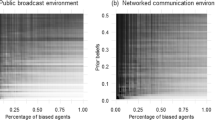Abstract
We develop an agent-based model of a Twitter environment to simulate using social-cyber (BEND) maneuvers to deter a disinformation campaign. We explore the use of the network maneuvers of back, build, and neutralize to manipulate the network and the information maneuvers of excite, dismay, explain, and dismiss to control the narrative. Using belief as a measure of effectiveness, we explore the changes in user behavior and the resulting network. We demonstrate that build is the most effective network maneuver countermeasure for deterrence. The results also show that affecting a tweet’s emotional and logical values through information maneuvers effectively controls the overall network belief.
Access this chapter
Tax calculation will be finalised at checkout
Purchases are for personal use only
Similar content being viewed by others
References
Bass, F.M.: A new product growth for model consumer durables. Manag. Sci. 15(5), 215–227 (1969)
Carley, K.M., Cervone, G., Agarwal, N., Liu, H.: Social cyber-security. In: Thomson, R., Dancy, C., Hyder, A., Bisgin, H. (eds.) SBP-BRiMS 2018. LNCS, vol. 10899, pp. 389–394. Springer, Cham (2018). https://doi.org/10.1007/978-3-319-93372-6_42
Beskow, D., Carley, K.M., Bisgin, H., Hyder, A., Dancy, C., Thomson, R.: Introducing bot-hunter: a tiered approach to detection and characterizing automated activity on Twitter. In: SBP-BRiMS. Springer, Heidelberg (2018)
Beskow, D.M., Carley, K.M.: Agent based simulation of bot disinformation maneuvers in twitter. In: 2019 WinterSim, pp. 750–761. IEEE (2019)
Carley, K.M.: Group stability: asocio-cognitive approach. Adv. Group Process. 7(1), 44 (1990)
Carley, K.M.: Social cybersecurity: an emerging science. Comput. Math. Organ. Theory 26, 365–381 (2020)
Carley, K.M., Martin, M.K., Hirshman, B.R.: The etiology of social change. Topics Cogn. Sci. 1(4), 621–650 (2009)
Daley, D.J., Kendall, D.G.: Stochastic rumours. IMA J. Appl. Math. 1(1), 42–55 (1965)
Hagberg, A.A., Schult, D.A., Swart, P.J.: Exploring network structure, dynamics, and function using networkx. In: Varoquaux, G., Vaught, T., Millman, J. (eds.) Proceedings of the 7th Python in Science Conference, pp. 11–15. Pasadena, CA USA (2008)
Heise, D.R.: Expressive Order Confirming Sentiments in Social Actions, 1st edn. Springer, New York (2007). https://doi.org/10.1007/978-0-387-38179-4
Pew Research Center: Internet, Science & Tech, Pew Research Center: Demographics of Social Media Users and Adoption in the United States (2021). http://www.pewresearch.org/internet/fact-sheet/social-media/. Accessed 26 April 2021
Maki, D.P., Thompson, M.: Mathematical Models and Applications: With Emphasis on the Social, Life, and Management Sciences, Prentice-Hall, Englewood Cliffs (1973)
McPherson, M., Smith-Lovin, L., Cook, J.M.: Birds of a feather: homophily in social networks. Ann. Rev. Sociol. 27(1), 415–444 (2001)
Morstatter, F., Pfeffer, J., Liu, H., Carley, K.M.: Is the sample good enough? Comparing data from twitter’s streaming API with twitter’s firehose. arXiv preprint arXiv:1306.5204 (2013)
Serrano, E., Iglesias, C.Á., Garijo, M.: A novel agent-based rumor spreading model in twitter. In: Proceedings of the 24th International Conference on World Wide Web, pp. 811–814 (2015)
Wang, C., Tan, Z.X., Ye, Y., Wang, L., Cheong, K.H., Xie, N.g.: A rumor spreading model based on information entropy. Sci. Rep. 7(1), 1–14 (2017)
Weng, L., Flammini, A., Vespignani, A., Menczer, F.: Competition among memes in a world with limited attention. Sci. Rep. 2, 335 (2012)
Zanette, D.H.: Dynamics of rumor propagation on small-world networks. Phys. Rev. E 65(4), 041908 (2002)
Acknowledgements
The research for this paper was supported in part by the Office of Naval Research (ONR) under grant N00014182106, the Knight Foundation, the United States Army, and by the center for Informed Democracy and Social-cybersecurity (IDeaS). The views and conclusions are those of the authors and should not be interpreted as representing the official policies, either expressed or implied, of the Knight Foundation, the ONR, the United States Army, or the US Government.
Author information
Authors and Affiliations
Corresponding authors
Editor information
Editors and Affiliations
Rights and permissions
Copyright information
© 2021 Springer Nature Switzerland AG
About this paper
Cite this paper
Blane, J.T., Moffitt, J.D., Carley, K.M. (2021). Simulating Social-Cyber Maneuvers to Deter Disinformation Campaigns. In: Thomson, R., Hussain, M.N., Dancy, C., Pyke, A. (eds) Social, Cultural, and Behavioral Modeling. SBP-BRiMS 2021. Lecture Notes in Computer Science(), vol 12720. Springer, Cham. https://doi.org/10.1007/978-3-030-80387-2_15
Download citation
DOI: https://doi.org/10.1007/978-3-030-80387-2_15
Published:
Publisher Name: Springer, Cham
Print ISBN: 978-3-030-80386-5
Online ISBN: 978-3-030-80387-2
eBook Packages: Computer ScienceComputer Science (R0)




